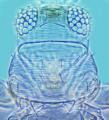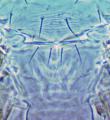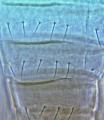Scirtothrips longipennis
Recognition data
Distinguishing features
Female fully winged. Body yellow, head light brown at anterior; tergites III–VIII and sternites V–VII with dark antecostal ridges; forewings strongly shaded in basal half, paler toward apex; antennal segment I pale, III–VIII dark. Head with ocellar region and vertex transversely striate; ocellar setae pair III further apart than their length, rising near margins of ocellar triangle; 2 pairs of post-ocular setae longer than ocellar setae III. Pronotum with transverse striae wavy and widely separated; 4 pairs of posteromarginal setae, S2 30 microns long. Metanotum weakly longitudinally reticulate, median setae close to anterior margin. Forewing first vein with 2–4 setae distally; second vein with 2 setae; posteromarginal fringe cilia wavy except near wing apex. Abdominal tergites II–V median setae close together, longer than distance between bases; lateral thirds of tergites with microtrichial fields bearing 3 discal setae; tergite VIII with no discal microtrichia medially, posteromarginal comb complete; tergite IX with discal microtrichia on posterior half. Sternites with microtrichial fields extending almost to S2.
Male not known.
Related and similar species
The country of origin and relationships of S. longipennis remain unclear. It was described from a greenhouse in Bruxelles, and no substantial wild population has yet been found. The genus Scirtothrips currently includes 100 listed species from various parts of the world. Bailey (1964) provided keys to 13 from North America, but that work was based on specimens that were not fully cleared, and thus few structural details were available concerning differences between species. Similarly, Johansen & Mojica-Guzman (1999) provided keys to 33 species from Mexico, but doubts have been expressed concerning the biological reality of many of these (Mound & zur Strassen, 2001). Hoddle & Mound (2003) provided information on 21 Scirtothrips species from Australia, and Rugman-Jones et al. (2006) produced a molecular key to several pest species in this genus.
Taxonomic data
Current valid name
Scirtothrips longipennis (Bagnall)
Original name and synonyms
- Euthrips longipennis Bagnall, 1909: 173
- Euthrips parvus Moulton, 1911: 15
Family placement
Thripidae, Thripinae
Biological data
Life history
Breeding on leaves
Host plants
Adults collected from many greenhouse decorative plants, including Anthurium, Dieffenbachia, Philodendron (Araceae), Begonia (Begoniaceae) and Cyclamen (Primulaceae) (zur Strassen, 2003).
Tospoviruses vectored
None
Crop damage
Feeding causes some leaf damage to ornamental plants.
Distribution data
Area of origin
Not known
Distribution
Southern Europe, Madeira, South Australia, Lord Howe Island.







